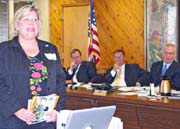Got a favorite place for viewing wildlife in the Meadowlands area?
The New Jersey Meadowlands Commission officially opened public participation for the creation of the New Jersey Meadowlands Birding, Wildlife and Fishing Trail system last week.
Lillian Armstrong from NJ Audubon Society in Cape May gave a presentation at the NJMC meeting on Wednesday in Lyndhurst. Hackensack Riverkeeper Hugh Carola also presented. The partnership will produce a full-color, free guide to promote the many trails and parks in the Meadowlands. NJMC granted the NJ Audubon Society $190,000 to create a guide that is due to hit the streets in June 2006.
Besides the usual stakeholders of the environmental community, this project elicits input throughout the district community. Site nominations have a Sept. 30, 2005 deadline.
“We’re looking to go beyond the standard agencies, such as the Department of Natural Resources, the Nature Conservancy and the like to reach out to local property owners, outdoor clubs and wildlife enthusiasts to nominate their special places for the trail guide,” Armstrong said. “To see what we see on a daily basis would be so fantastic for those who don’t know its there.” The area designated for the tour routes include the 19,485-acre NJMC district. The entire Hackensack River watershed is also part of the program. Potential trails can extend as far as the NY/NJ border and lush viewing places between the Passaic and Hudson River. Nominated sites can be any place where any type of wildlife can be seen. Spots with great views or ideal natural features may be included.
Call for nominations
“Every birder has their special spot where they can see different species – the angler or boater who may want to share a special place too. Fill us in on what you know,” said Carola.
The project is part of a continuing initiative to encourage people passing through the area, whether to relax for the weekend or to have a full-fledged vacation, to stop for a little eco-tourism. NJMC outreach naturalist Gabrielle Bennett-Meany said the booklet will tie in all the “little driving loops” around the district that may be common to locals but not to any one else.
Targeted are tourists on their way to New York City or heading to a hotel or convention center in New Jersey who may want to include a bit of outdoor fun while in the area.
“There is an amazing oasis in the mosaic of parks hidden in between the highways,” Bennett-Meany said. “Vacationers looking for a touch of nature in their trip would reference all these wonderful spots through the guide.”
Members of the public are invited to fill out a six-page nomination form found online at www.njmeadowlands.gov or www.njaudubon.org/bwt. Schools, civic organizations and other residents or visitors are encouraged to send in their favorite places for viewing birds, mammals, reptiles, insects, vegetation or any interesting outdoor spots, whether on land or water.
A visit by program organizers can be arranged by calling NJMC for any group wanting a presentation. “There is all sorts of wildlife in the Meadowlands, and we want to point out the various ways to enjoy it – whether walking or canoeing the trails,” said Bennett-Meany. “Think of it like people going to Disneyland who make a special Everglade trip. We want that kind of connection.”
The Meadowlands feature more than 900 animal and plants species. Of the 260 bird species reported, 65 nest in the marshes and other landforms.
In the wild ions
Debra Davidson of the Tenafly Nature Center was on hand to show off two of New Jersey’s frequent flyers that have handed in their wings. Gem, a red-tail hawk and Mitsy, a barred owl, are rehabilitated birds that call the Bergen County facility home. Gem lost a wing and talon after flying into a power line 15 years ago. Mitsy permanently damaged a wing recently while feeding alongside a busy highway.
The red-tail hawk is quite common in the Meadowlands, according to Carola. The owl, a nocturnal species, has a small population in pine forested areas, or near the upper watershed areas in New Jersey.
“Birds are an indicator species of any environment. While the area may be still be dangerous in some ways, a healthy wildlife population speaks of an environment in recovery,” said Carola.
HELP US OUT – Lillian Armstrong of NJ Audubon Society gave a presentation about a trail guide in the works to NJ Meadowlands Commission members at Wednesday’s meeting. Public participation is requested to nominate favorite wildlife viewing spots in the district.
